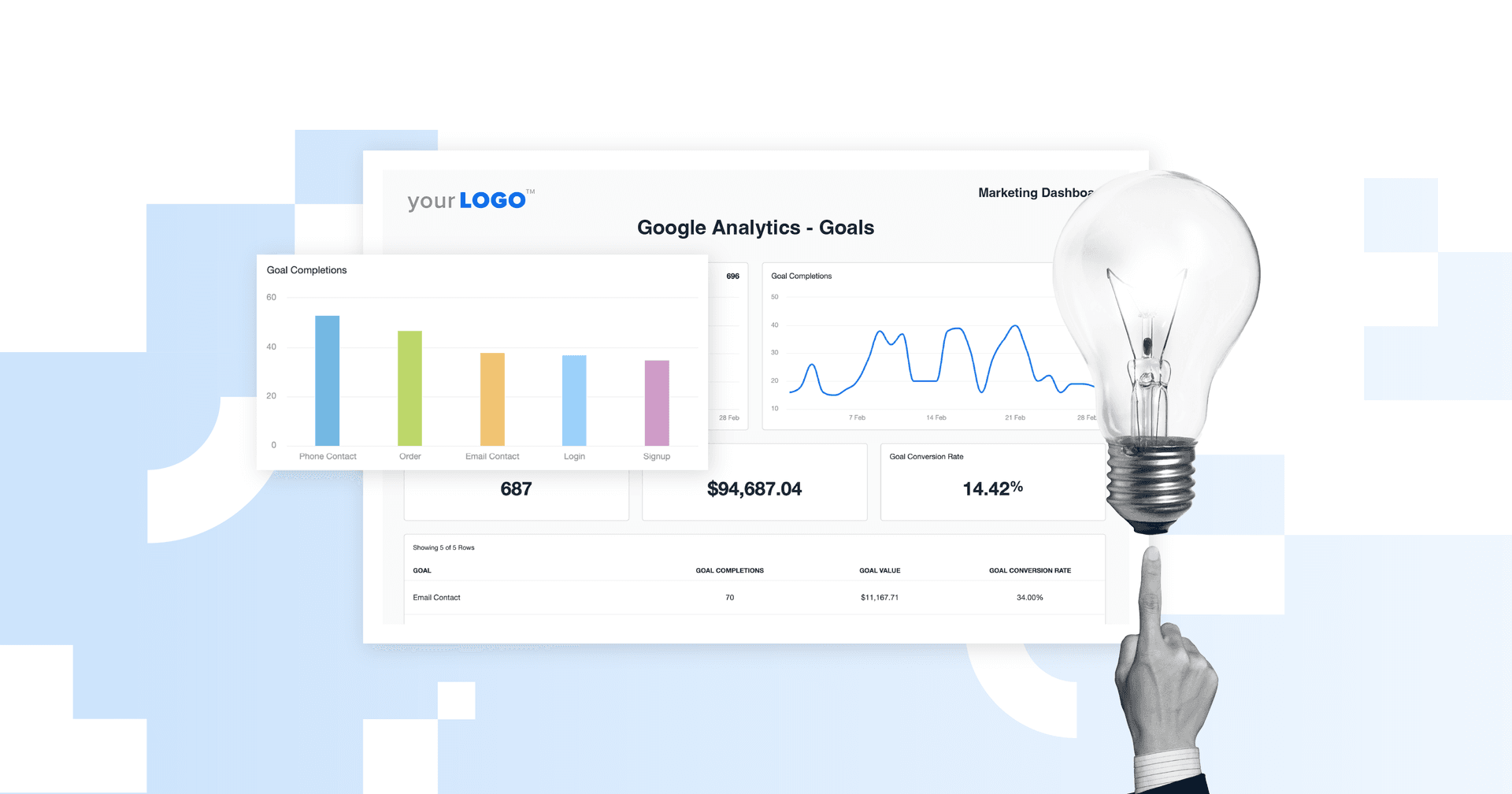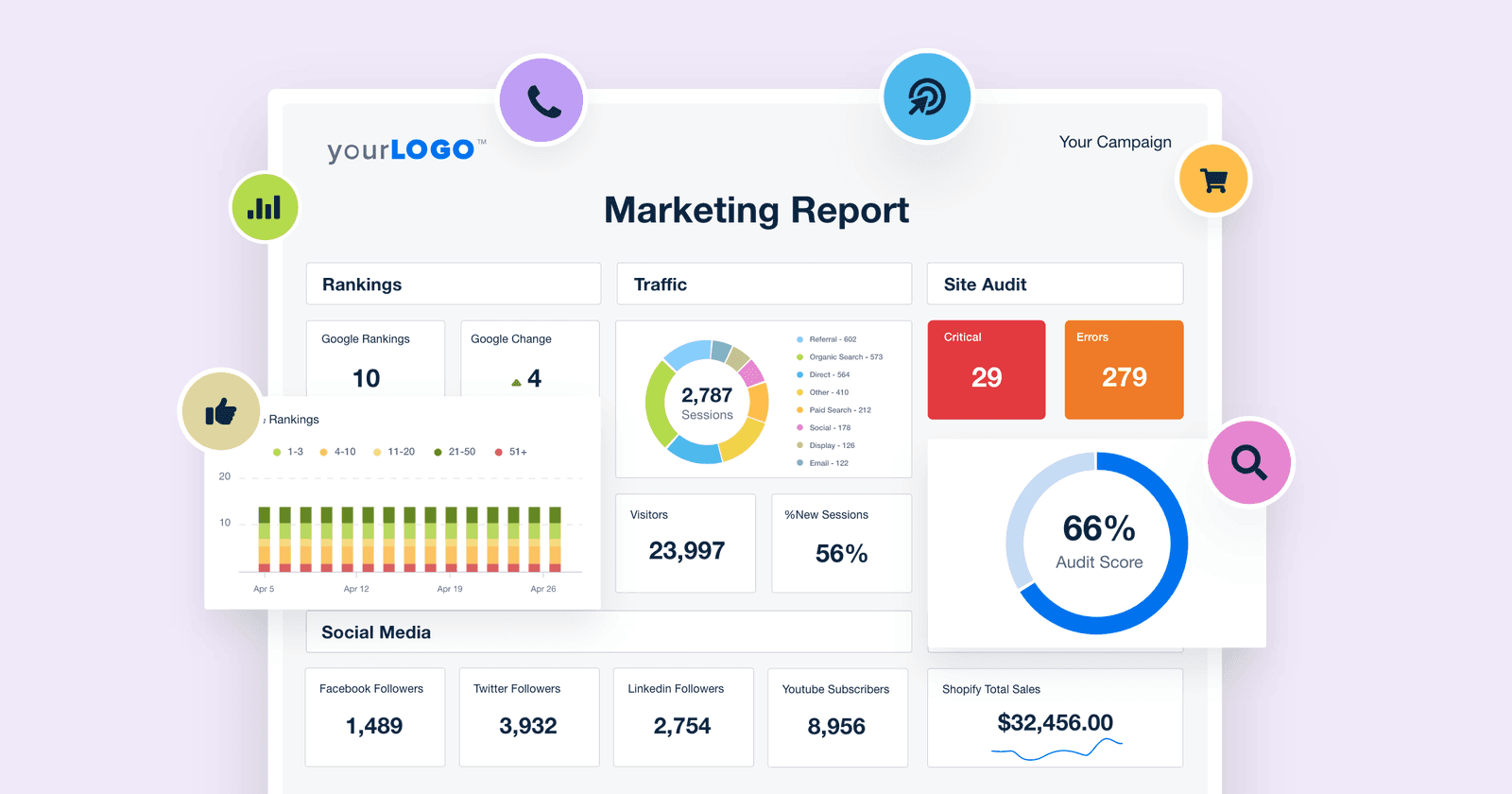Table of Contents
Table of Contents
- Why Do Marketing Metrics Matter for Agencies?
- The Marketing Metrics Power Triangle
- Focusing On The Metrics That Move The Needle
- 3 Different Ways to Segment Marketing Metrics
- The Importance of Clarity and Transparency With Marketing Metrics Reporting
- How To Measure and Report on Marketing Metrics Using AgencyAnalytics
- Summary and Key Takeaways
7,000+ agencies have ditched manual reports. You can too.
Free 14-Day TrialQUICK SUMMARY:
Marketing metrics help gauge campaign performance, guide budget allocations, and optimize client outcomes. This article unpacks essential metrics, from conversion rates to net promoter scores, and introduces the Marketing Metrics Power Triangle to balance traffic, conversions, and value. Effective communication of these metrics solidifies client relationships by showcasing your agency's strategic expertise and the tangible results of your marketing efforts.
Your agency's success hinges on the masterful application of marketing metrics. It's more than just tracking numbers; it's about mining the gold from the data deluge and translating it into actionable insights that propel your clients' businesses forward.
Understanding marketing metrics isn't a mere task–it's imperative. Amid the constant hum of data, knowing how to discern the signal from the noise is what separates marketing leaders from the rest. Does your agency merely toss an avalanche of data at clients, or does it meticulously distill it down to the essential marketing metrics and key performance indicators?
In this comprehensive guide, we will introduce three powerful frameworks used by top global agencies to prioritize and scale the metrics that truly matter. We will also reveal strategies to streamline your marketing metrics reporting, enabling you to deliver tangible value and actionable insights faster. These insights will help you retain your clients and contribute to their growth.
Stay tuned, as we work to transform your agency's approach to marketing metrics, setting a new standard for data-driven decision-making. What you’ll discover in this article:
Why Do Marketing Metrics Matter for Agencies?
“The reason why clients hire a digital marketing agency is to get improved results from their website or marketing initiatives. You can't improve what you don't track,” says Nathan Hawkes, President of Arcane Marketing.
And few clients will be happy with the idea of blindly spending money without understanding the return on that investment.
As Jessica Weiss, the Director of Marketing & Strategic Program at One Firefly, puts it, “this clarity sets our team members up for success as they walk clients through our performance and ROI for their investment.”
Marketing metrics are the fundamental elements to understanding campaign performance and results. They help inform budget allocation decisions so that resources are used efficiently and effectively to reach desired outcomes.
Are the client’s PPC campaigns delivering a higher-than-expected ROI? Perhaps it’s time to increase the investment and drive more growth.
Are the paid social media campaigns driving lots of engagement but few clicks or sales? That might indicate a need to rethink the overall messaging strategy.
Marketing metrics are like the signs and traffic signals that help you get from one part of the country to another without driving off a cliff somewhere near Colorado.
We believe in the power of data-driven decision-making and use it to inform all of our strategies. We regularly track and analyze key performance metrics, using the insights we gain to refine our approach and drive better results for our clients.
Adam Binder, Creative Click Media
The Marketing Metrics Power Triangle
The marketing metrics Power Triangle is a helpful concept for understanding the relationship between the key levers in marketing performance. It’s made up of three components: traffic, conversion, and value–all equally essential to marketing success.
Traffic: How many people are driven to a website or physical location from marketing initiatives?
Conversion: How often do those visitors convert to paying customers?
Customer Value: How much does each customer spend? This is typically expressed as AOV (average order value) or eCommerce clients, but could be MRR (monthly recurring revenue) or another key performance indicator for SaaS clients or business services.
A balanced approach across all three elements of the marketing metrics power triangle will maximize marketing results for agencies.
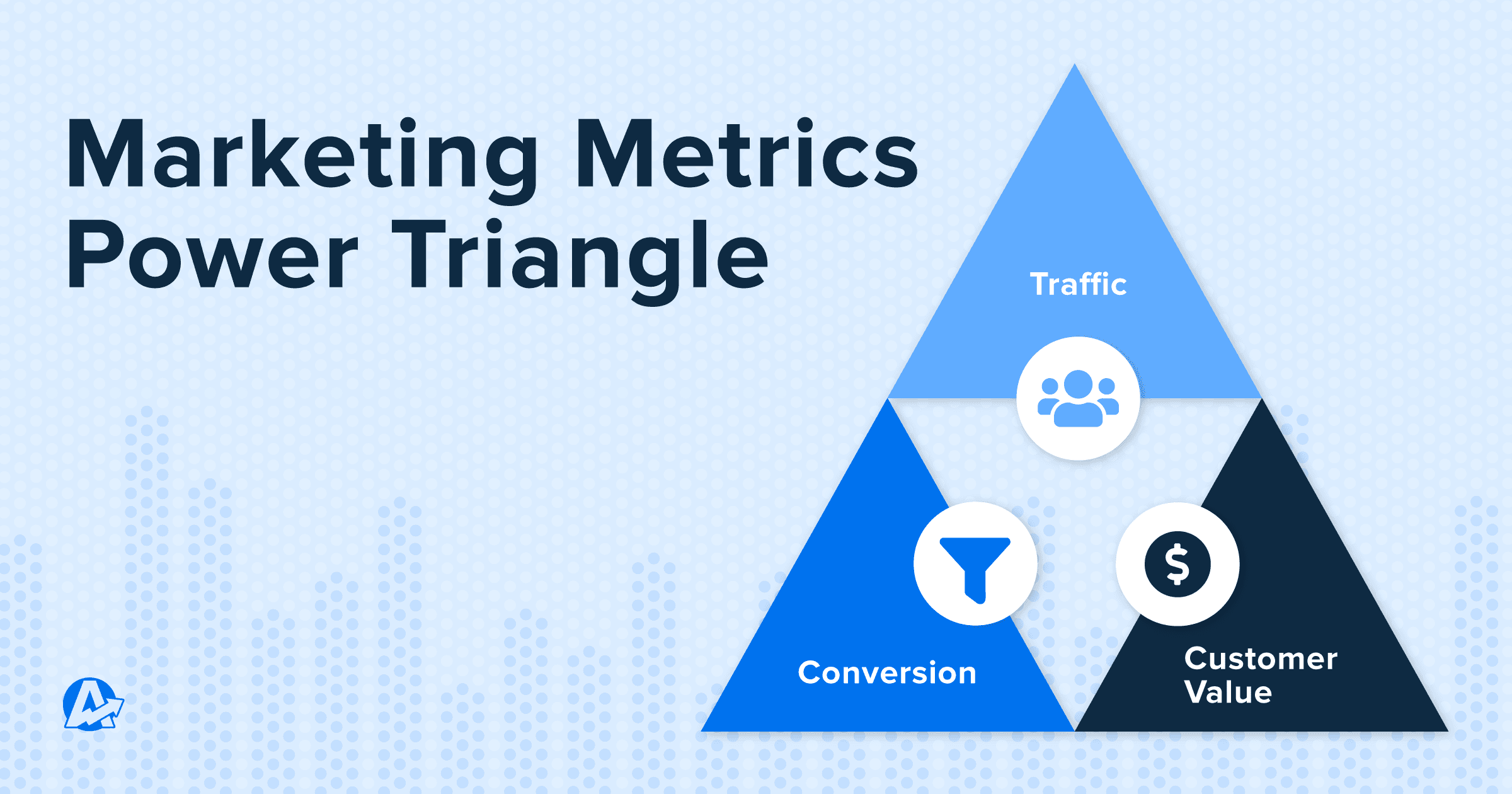
Example: Balancing an eCommerce Client’s Marketing Funnel
Imagine your agency has been tasked with optimizing an eCommerce client's marketing funnel to bring in new customers. You decide to leverage the Marketing Metrics Power Triangle—traffic, conversion, and average order value—as your strategic metrics for assessing the campaign's success.
Goal 1: Traffic
The first point of the triangle, traffic, represents the total number of people visiting your client's website. You've decided to invest a significant portion of the marketing budget into search engine optimization (SEO) to increase organic traffic. Over time, as your SEO efforts start bearing fruit, you witness an uptick in website visitors—your target audience is finding your client's site via search engines.
Goal 2: Conversion Rate
Next, you turn your attention to the second point of the triangle—conversion rate. Here, you're interested in how many of these visitors are converting into marketing- qualified leads and customers. Despite the increased traffic, if the conversion rate remains low, your marketing investment won't yield the expected returns. So, you work on improving the website's user experience, enhancing product descriptions, and implementing a streamlined lead capture and checkout process. Over time, you notice that more visitors are turning into sales- qualified leads or customers.
3: AOV
Finally, the third point of the triangle is the average order value (AOV), which represents the average amount each customer spends per transaction. To increase the AOV, you implement strategies like product bundling, upselling, and cross-selling. Over time, you observe that customers are not just making purchases, but their order values are also increasing.
By balancing these three elements of the Marketing Metrics Power Triangle, you ensure that your client’s marketing spend is being used effectively. If one point of the triangle is lagging, it can be identified and addressed promptly.
For instance, if you're getting high traffic but low conversions, it might be worth reassessing your marketing funnel or website's user experience. If conversions are high, but the AOV is low, you might need to focus more on upselling or increasing the perceived value of your client's products.
In this way, the Marketing Metrics Power Triangle provides a holistic view of your marketing performance. It helps you to identify which marketing activities are working, which strategies need tweaking, and where to allocate your marketing budget for maximum returns. By keeping a close eye on your cost per lead in relation to these three points, you can ensure that you're driving the most value for your clients.
How To Use the Power Triangle To Drive Compound Growth
One of the most important aspects of this triangle is understanding how improving any of the three will typically increase revenue, but increasing all three can drive a compounded impact on the bottom line.
To dig deeper into the power triangle, let’s say your client has the following:
10,000 visitors per month |
2% conversion rate |
$400 average spend per customer |
= $80,000 per month in revenue |
You can see how these three metrics work together to drive the revenue. Any one of them falls dramatically, and the entire revenue picture collapses.
From a growth perspective, it’s about aligning all three to maximize the client’s potential.
Driving traffic that converts at an appropriate rate and spends the right amount of money with the client’s business. You can almost think about it like a troubleshooting flowchart.
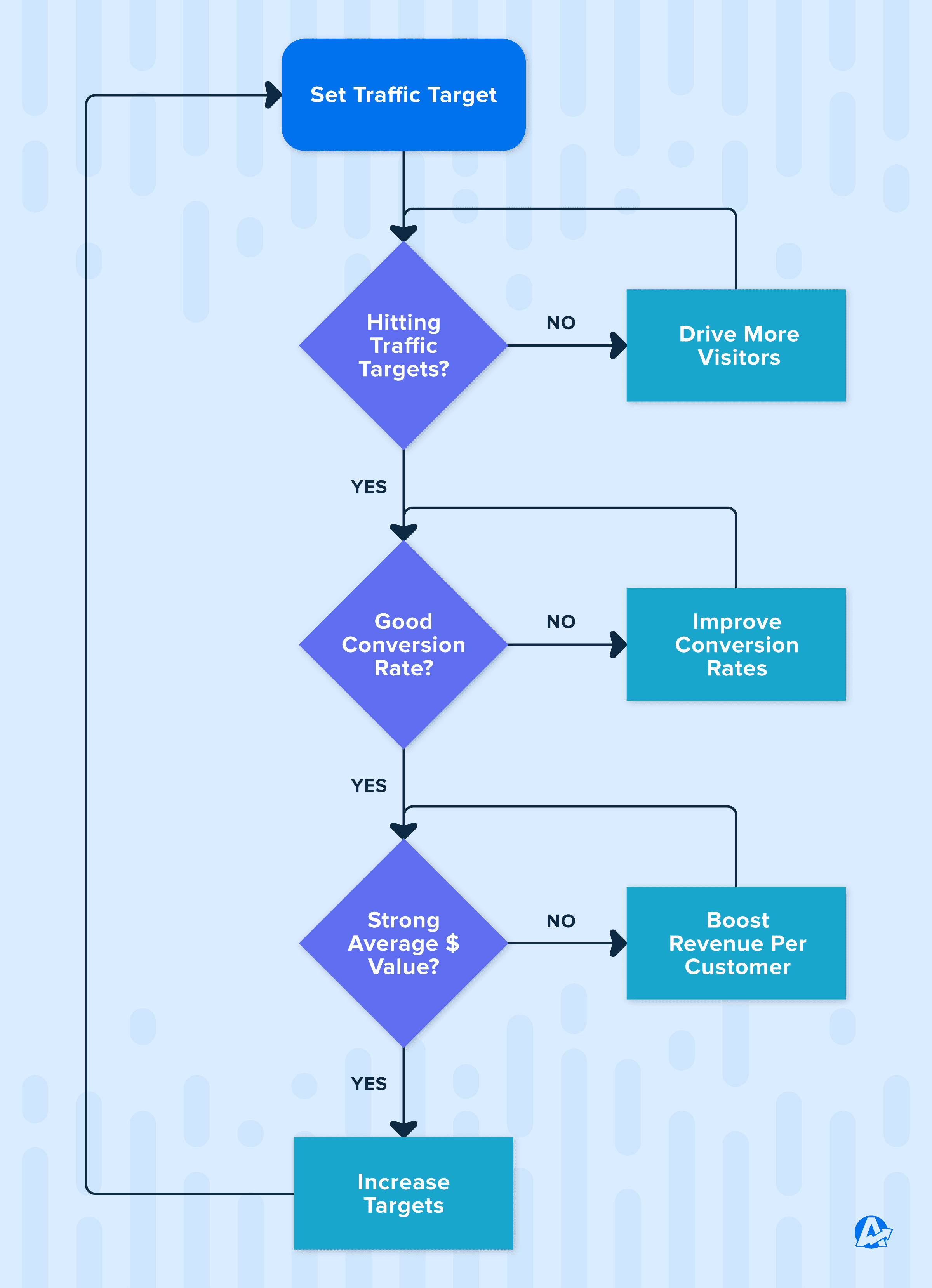
If your team can increase visitors by 10%, but the other marketing metrics remain the same, the result is a 10% increase in total revenue. That, in itself, is not too shabby.
11,000 visitors per month |
2% conversion rate |
$400 average spend per customer |
= $88,000 per month in revenue |
But let's say your team achieves a 10% increase across all three aspects of the power triangle:
11,000 visitors per month |
2.2% conversion rate |
$440 average spend per customer |
= $106,460 per month in revenue |
You'd be forgiven if you thought that a 10% increase in visitors + a 10% increase in conversion rate + a 10% increase in revenue per customer would equate to a 30% increase in total revenue. But that's not actually the case. Because they compound upon each other, the total increase comes in at just over 33%
The marketing metrics power triangle can be applied to marketing efforts in various ways.
Identifying the leaks in the customer acquisition pipeline
Create compounding improvements that drive the entire business
Offer low-hanging fruit opportunities for improvement
First and foremost, your marketing team should focus on improving each individual element of the triangle–traffic, conversion rate, and value per customer. There is no one-size-fits-all formula for this; it will depend on the needs and goals of each particular marketing campaign.
Focusing On The Metrics That Move The Needle
As Cheryl Ingram, the Managing Director of The Digital Media Collective, advises, “report on what’s necessary rather than everything and anything.” She says that your client report templates need to be meaningful, understandable, and include the most important pieces: We did this–and the result was that,’ or ‘We noted this and will be taking the following action.’”
I always look at data and ask myself SO WHAT? If the report doesn’t answer The SO WHAT question, then don’t send it.”
Cheryl Ingram, The Digital Media Collective
When marketing agencies focus on key marketing metrics, they provide more valuable insights for their clients. For example, tracking website visitors over time reveals trends that allow marketing experts to understand how campaigns are performing not just today but over time.
Our team relies heavily on the data we collect to make decisions that produce real results for our clients. It's our job to tell a simple story through reporting to our clients. Clients love seeing progress over time, and we try to show that with a number of our metrics.
Brian Ferritto, 42connect
1. Show the Big Picture
This includes tracking conversions from various marketing channels, such as email campaigns, Google Ads, SEO, and social media posts. By looking at these metrics together, marketing teams focus on what is really moving the needle, which is a win-win for the client and the agency.
Moreover, focusing on key marketing metrics allows agencies to identify areas for improvement quicker than if they had simply provided raw data to their clients.
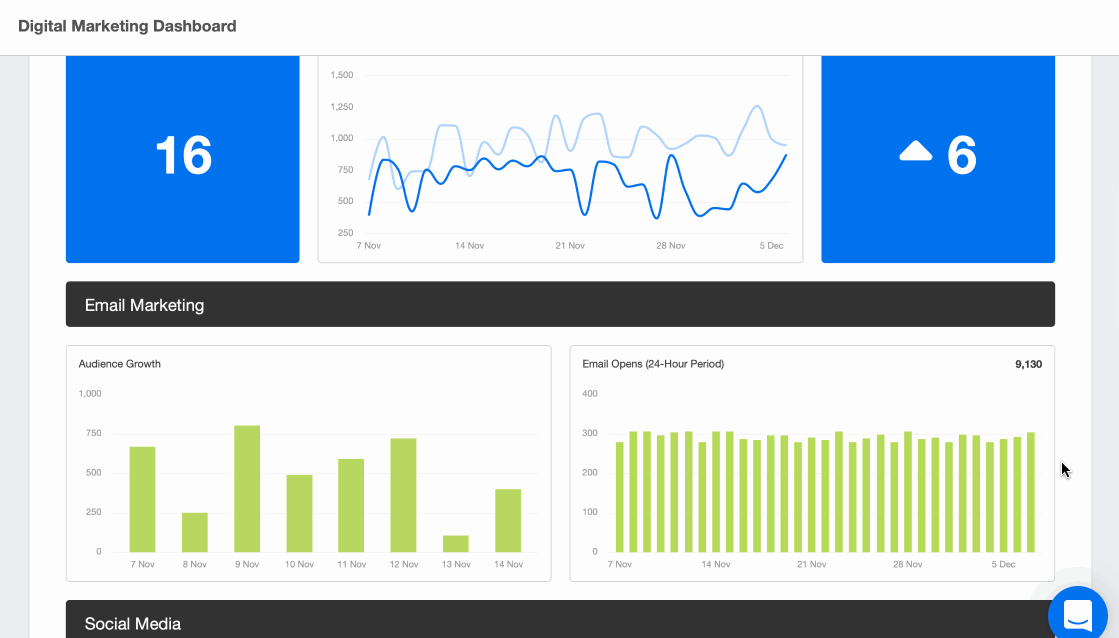
Use the Digital Marketing Dashboard to quickly convey all of your agency’s digital marketing success, or check out all of the other dashboard templates available on the platform.
2. Keep It Simple
One of the key advantages of creating thoughtful client reports is taking a moment to actually sift through the data to identify outliers. For instance, low email open rates but high click-through rates (CTRs) could indicate an issue with their subject lines or preview text.
Clients want to see real-time data and analytics, but they don't understand metrics or look at metrics the same way we do. To us, a conversion from PPC is a call. To a client, a conversion is money in the bank. So, having the ability to show SEO & PPC results with traffic next to a revenue number–speaks volumes.
Ruben Roel, Investigator Marketing
The bottom line is that instead of overwhelming everyone with useless statistics, marketing experts should take the time to identify which KPIs and metrics are most important and provide meaningful insights based on those findings.
3. Customize for Maximum Impact
Make sure you select marketing KPIs that can be used for both short-term optimizations as well as long-term strategic planning.
When we look at the effectiveness of our team members, time management and focus are key components in measuring that success. AgencyAnalytics not only enables the team to have useful data at their fingertips but also presents it in a palatable way for our clients to digest. Beyond time savings, the platform helps us keep the client conversation centered on strategy vs. chasing down metrics and helping the client understand them.
Jessica Weiss, One Firefly
Work with clients to help identify what matters most to them. Be sure to include marketing metrics that provide the insights your clients need. Not enough data, and your client will be left wondering what is happening with their campaigns. Too much data can end in information overload or analysis paralysis, which is just as damaging to your agency-client relationship.
Many of our client relationships require customized reports because they don't want to see seven reports, one per platform. They want everything condensed into one easy-to-read report, where they can view all of their most significant marketing data in one place.
Graham Lumley, Blackhawk
Consider including this fact-finding mission in your discovery meeting or client onboarding process. That way, your team will know which marketing metrics matter to the client and can subsidize them with the ones you know will help showcase your team's performance. And avoid vanity metrics whenever possible!
Vanity metrics, by and large, are a waste of time for both you and the client. Trying to show improved metrics to make you look good will take away from your efforts of reaching the actionable metrics that will prove your marketing worth to the client.
Nathan Hawkes, Arcane Marketing
3 Different Ways to Segment Marketing Metrics
Marketing metrics are used to track marketing activities and campaigns across the entire spectrum of marketing. Essentially, if you can measure it, it can become a metric. So it helps to look at it through a certain lens. Let's take a closer look at the following three ways:
Method 1: Selecting Metrics Based on Key Objectives
Simply put, they measure marketing performance based on what you are trying to achieve–and therefore reflect your agency's performance–such as website visits, conversion rates, email open rates, cost per acquisition (CPA), return on ad spend (ROAS), and more.
Although there are hundreds (if not thousands) of marketing metrics to choose from, they can usually be bucketed into ten unique categories.
Metric Type | What It Means |
|---|---|
Sales or Revenue Metrics | Provide insights into how marketing efforts drive revenue for a client. These are probably the most important conversion metrics as they are the ones that impact the client's bottom line. |
Lead Metric | Measure not just the number of leads generated but their quality. Includes total lead count, qualification rates to marketing qualified lead or sales qualified lead, cost per lead, and lead-to-sale conversion rates. These metrics are where the client's sales and marketing teams should be closely aligned.
|
Cost Metrics | Measure marketing spend and efficiency by tracking key financial indicators such as the total spend but also breaking that down into key sectors such as Cost per Click (CPC), Cost Per Lead (CPL), and Cost Per Acquisition (CPA). For example, a keyword driving a low Cost Per Click is great, but cheap traffic that doesn't generate revenue or drive qualified leads into the sales team, or does so at too high of a customer acquisition cost, does not benefit the client or the agency.
|
Brand Awareness Metrics | These focus on tracking the marketing strategy implemented to build brand awareness or loyalty. This includes key marketing metrics such as reach, post impressions, shares, brand recall, and engagement across different channels. |
Website or Foot Traffic | How many people visit the client's website (i.e., page views, new visitors, returning visitors, and time spent on site/page), or retail location (foot traffic). |
Conversion Rates | Allow marketing professionals to track how many visitors or leads converted into paying customers (or qualified leads) after marketing campaigns were executed. Conversion metrics are an essential piece of the marketing metrics puzzle because they help guide if marketing activities are producing a reasonable ROI for clients. |
Average Customer Value | AOV is typically used in E-commerce marketing, as it measures the average revenue for each unique transaction. On the other hand, ARPU (Average Revenue Per User) tracks the recurring revenue that each user will generate as long as they maintain their current subscription. |
Reputation Management Metrics | Tracks reviews, ratings, net promoter score, and feedback from existing customers across different marketing channels, such as social media platforms and review sites. This kind of marketing metric is important in assessing brand reputation, so your team can make adjustments if needed. Such as a sudden influx of negative reviews that bring down a client’s average rating. |
Customer Lifecycle / Customer Lifetime Value (CLV) | Gives marketing teams an overview of how existing customers remain active with a business or product over time and how much they are likely to spend during the entirety of their business relationship, driving the customer lifetime value metric. Remember, a higher customer lifetime value can justify a higher customer acquisition cost. |
Growth Rate | Assesses marketing efforts and their effectiveness in driving growth for a business or marketing channel. It's also essential for understanding the trajectory of the business. |
Actionable Metrics are valuable numbers that fuel marketing and can be associated with clearly defined and measurable outcomes.
Cheryl Ingram, The Digital Media Collective
Tracking these key marketing metrics provides valuable insights into current marketing efforts and ensures they deliver the best possible results for clients. They can also help inform new marketing opportunities that can be used to drive sales, marketing qualified leads, and more.
Summarizing the Most Important Marketing Metrics by Objective
To boil this down to the core of how a marketing metric should be used; business objectives vary, and so do the marketing metrics that best reflect progress toward achieving them.
Whether your agency’s goal is to increase sales, generate leads, manage reputation, or improve customer lifetime value, there's a suite of key metrics that provide the insights you need. Understanding and tracking these metrics is crucial to business success, helping you to:
Optimize your marketing investment,
Reach your target audience, and
Grow sustainably.
The following table illustrates key marketing metrics corresponding to different business objectives, from leads generated to net promoter score and customer acquisition cost (CAC).
Business Objective | Examples of Marketing Metrics |
|---|---|
Sales or Revenue Metrics | Total Sales, Revenue Growth Rate, Average Revenue per Sale, Gross Profit Margin |
Lead Metrics | Leads Generated, Marketing Qualified Leads, Sales Qualified Leads, Lead Conversion Rate |
Cost Metrics | Customer Acquisition Cost, Cost per Lead, Cost per Click, Return on Marketing Investment |
Brand Awareness Metrics | Brand Recognition, Brand Recall, Brand Sentiment, Share of Voice |
Website or Foot Traffic | Total Visits, Unique Visitors, Bounce Rate, Page Views per Visit |
Conversion Rates | Conversion Rate, Shopping Cart Abandonment Rate, Call-to-Action Click-through Rate |
Average Customer Value | Average Purchase Value, Purchase Frequency, Customer Lifetime Value |
Reputation Management Metrics | Net Promoter Score, Customer Satisfaction Score, Online Reviews and Ratings, Social Media Mentions |
Customer Lifecycle / Customer Lifetime Value | Customer Retention Rate, Customer Lifetime Value, Repeat Purchase Rate, Existing Customer Growth Rate |
Growth Rate | Revenue Growth Rate, Customer Growth Rate, Market Share Growth Rate |
By focusing on these metrics, you ensure your marketing efforts are aligned with your client’s business objectives and contribute to a positive return on investment. These indicators provide valuable insights into your current performance and areas where there is room for improvement.
Method 2: Using Marketing Funnel Metrics (ToF, MoF, and BoF)
The second way to segment metrics is by looking at where the user is in their purchase journey and which marketing metric (or metrics) best aligns with that stage. This is typically broken down into three key steps that also align with the well-known AIDA framework of Awareness, Interest, Decision (although, sometimes, Desire is used in its place), and Action.
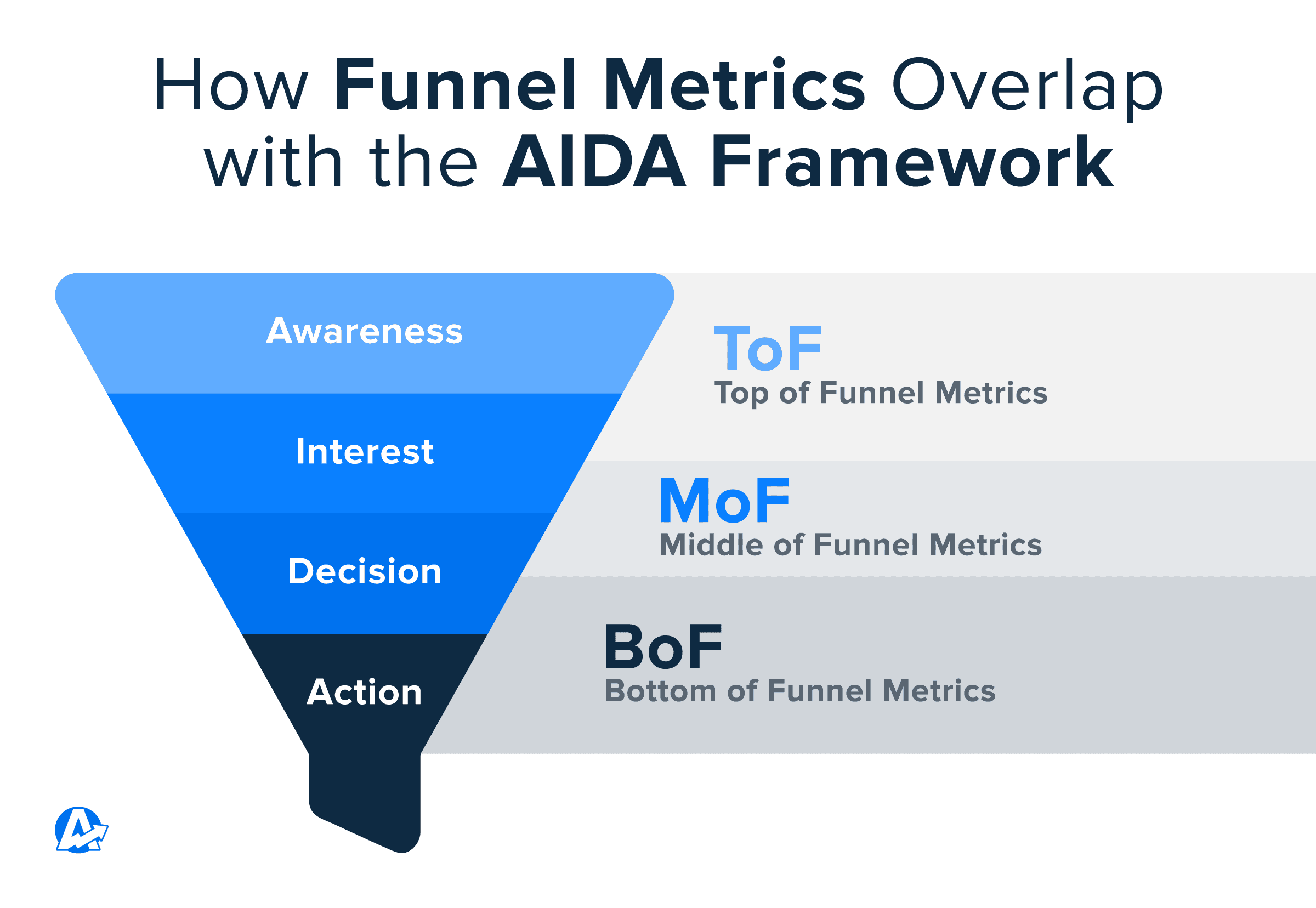
Connecting the right marketing metrics with the customer journey is essential in crafting a tailored marketing strategy that addresses each stage of the funnel-from top (awareness), middle (consideration), to bottom (decision).
This alignment ensures you're tracking the right marketing metrics at each stage, differentiating between a marketing qualified lead at the top of the funnel and a sales qualified lead closer to the bottom, thereby enhancing customer lifetime value and refining your key performance indicators.
ToF (Top of Funnel) Metrics | MoF (Middle of Funnel) Metrics | BoF (Bottom of Funnel) Metrics |
|---|---|---|
The goal of this kind of marketing strategy is to capture the attention of potential customers at first touch. Marketing Metric Examples: website visits, blog views, PPC clicks, and social interactions. | Track the customer journey as they move through the consideration phase and are closer to making a purchase decision. Marketing Metric Examples: add-to-cart rates, email signups, and lead generation (including if they are marketing qualified leads or sales qualified leads). | Measure marketing campaign performance at the opportunity and customer level (when customers are close to making a purchase decision). Marketing Metric Examples: shopping cart abandonment, lead qualification rates, sales, revenue, reorder rate, customer lifetime value (CLV), net promoter score, and ROI. |
Because the marketing funnel is such a clear representation of the customer journey, measuring key performance indicators (KPIs) at each stage of this funnel provides valuable insights into the effectiveness of your marketing efforts.
Understanding where your agency is successfully engaging potential customers and where there might be room for improvement is the very foundation of continuous improvement.
Digging Into the Funnel Marketing Metric Examples
This tracking is crucial in optimizing marketing ROI, reducing cost per lead, and enhancing conversion metrics (not to mention making the sales team happy).
From top-of-funnel awareness metrics to bottom-of-funnel conversion and retention metrics, understanding the right marketing metrics to track at each stage helps your client’s sales team convert more leads and secure repeat business. The following table details some of these key metrics:
Funnel Stage | Examples of Marketing Metrics |
|---|---|
Top of Funnel | Website Traffic, Social Media Reach, Brand Awareness, Cost per Thousand Impressions (CPM) |
Middle of Funnel | Engagement Metrics (likes, shares, comments), Email Open Rates, Cost per Lead, Marketing Qualified Leads generated, or Product Qualified Leads (typically for SaaS businesses) |
Bottom of Funnel | Conversion Rate, Sales Qualified Leads, Customer Acquisition Cost, Retention Metrics, Customer Lifetime Value, Marketing ROI |
Aligning your marketing efforts with each stage of the customer journey is all about delivering the right message at the right time, ultimately guiding your client’s prospects down the funnel and turning them into loyal customers.
Method 3: Breaking Them Down By Channel
Another way to identify your clients' most important marketing metrics is by breaking each marketing metric down by channel or campaign. The individual marketing tactic will have a different set of metrics or key performance indicators that help differentiate between success and failure.
For example, email marketing requires tracking different metrics than organic search marketing or pay-per-click marketing. Here are some of the key digital marketing metrics for each channel, including:
1. Website Metrics
Tracking website metrics gives marketiers valuable insights into:
Customer preferences,
interests,
spending patterns,
demographics, and more.
For example, by tracking key website performance indicators such as page views, time on page, and bounce rate, agencies identify areas where visitors are dropping off or are having difficulty navigating the site. This information can be used to update the user experience on a website and improve engagement levels.
We have had new leads contact us who said their old agency would rarely offer an update or would send them a report full of buzzwords & confusing data. This would be the main reason they swapped over to use our service. I often show new leads an example report, and they are impressed with how straightforward & easy to understand it is.
Guy Hudson, Bespoke Marketing Plans
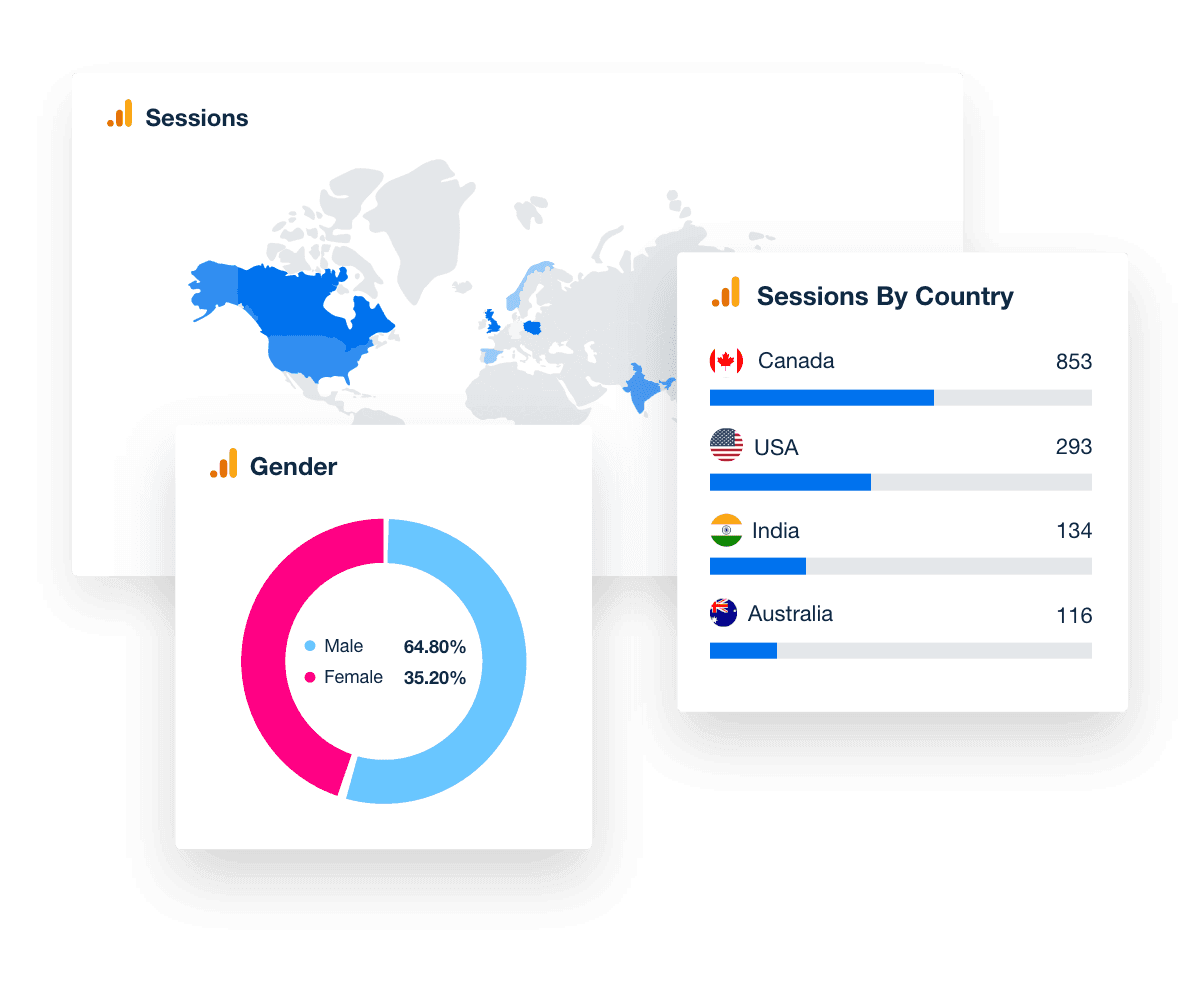
Bring all your clients’ marketing metrics under one roof by combining Google Analytics with over 80 other marketing platforms. Start your free 14-day trial today.
2. Paid Marketing Metrics
Paid marketing metrics are incredibly important for marketing teams as they provide key insights into the success of marketing efforts and whether or not the client’s money is being invested properly.
They include a range of tactics, such as pay-per-click (PPC) marketing and digital media advertising, effectively reaching target audiences more quickly and cost-effectively than traditional marketing methods.
PPC ads are a key part of our clients' digital marketing strategies as they drive measurable impact toward our clients' goals. Whether it's driving brand awareness, increasing sales, or generating more leads, PPC ads allow for real-time control over ad spend, targeting, and creative to most effectively get in front of our clients' desired audiences.
Reed Emerson, Avenue Agency
Paid advertising data, such as Google Ads metrics, identify areas for improvement in terms of targeting, budgeting, and messaging. Additionally, paid marketing metrics help marketers optimize campaigns to get the most out of their budget by pinpointing which ads or keywords yield the best results in terms of conversions or engagement.
PPC goals are created by determining what the client needs to grow and defining metrics within the PPC dashboard to match it. For example, we utilize close rate, website traffic, and tracked conversion actions to find the whole picture and link it to overall lead and revenue growth.
Rebecca Pena, Investigator Marketing
Another benefit of tracking paid marketing metrics in a single platform is that it makes it easier to compare different campaigns side by side, giving advertisers a clearer view of which strategies work best for their particular goals. That way, ROAS (Return on Ad Spend) or cost per marketing qualified lead can quickly and easily be compared between Google, Meta, LinkedIn, and more.
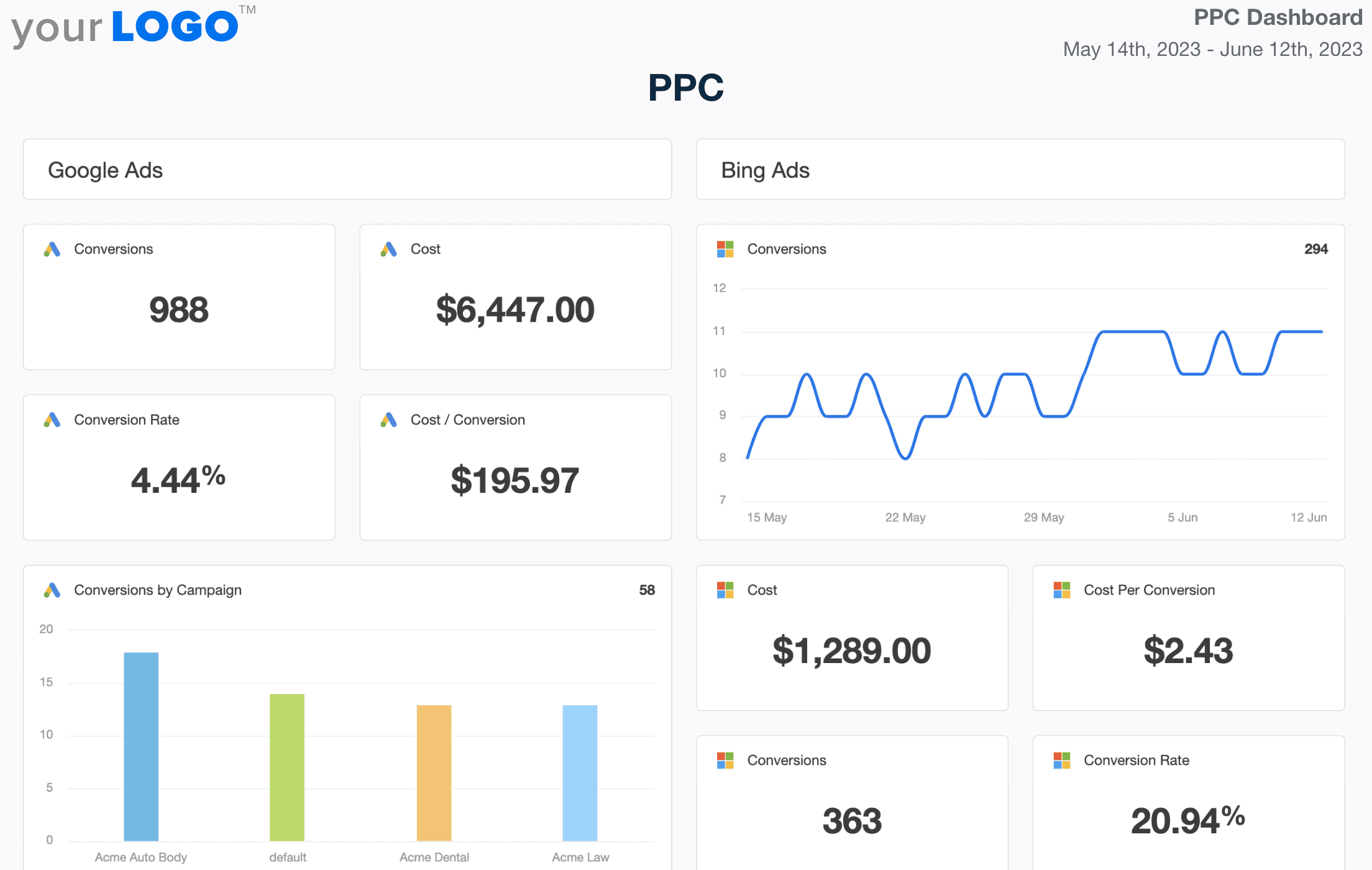
Use a PPC Dashboard to highlight your agency's success with paid ads. Google Ads is just one of the over 80 platform integrations that are included at no extra cost. Try AgencyAnalytics free for 14 days!
3. SEO Marketing Metrics
Although the end goal of SEO marketing is to drive visitors, leads, and sales from organic search listings, several key leading indicators make up any successful search engine optimization strategy, and these elements need to be tracked to ensure overall success.
One of the most important SEO marketing metrics is keyword rankings. After all, if your client can’t be found, the rest of the potential customer journey will sit in silence, waiting patiently for new customers.
Tracking keyword rankings allows marketing teams to understand how well they rank in SERPs for specific keywords or phrases that their target audience will likely use when searching online.
But rankings alone don’t hold much meaning if you aren’t targeting the right keywords for each client.
We conduct extensive market research, including competitor analysis at the start of a new campaign, to 'find out the why' of our clients and decide where they are likely to succeed online. For example, if the client is reasonably well known, we wouldn't include website traffic generated by branded searches as a key metric, but–instead–we would work on doubling, tripling, or 10x-ing the unbranded searches that don't mention the client's name.
Daniel Noakes, UClimb
Another key metric for SEO marketing is backlinks.
Google can't yet make a qualitative decision about a website. It can tell what it's about, but it can't tell if it's important or useful just by reading the site. One of the main factors it uses to determine importance is backlinks because these act as "votes of confidence." If it trusts the sites that are linking to you, you get a portion of those referring sites' trust. It's just that simple.
Jens Rhoades, Floodlight SEO
Finally, it’s also important to monitor website speed and technical performance as part of an effective SEO marketing strategy. Slow loading times can hurt user experience as well as dampen organic search visibility, so it’s essential that the web team ensures that websites are properly optimized for both new and existing customers.
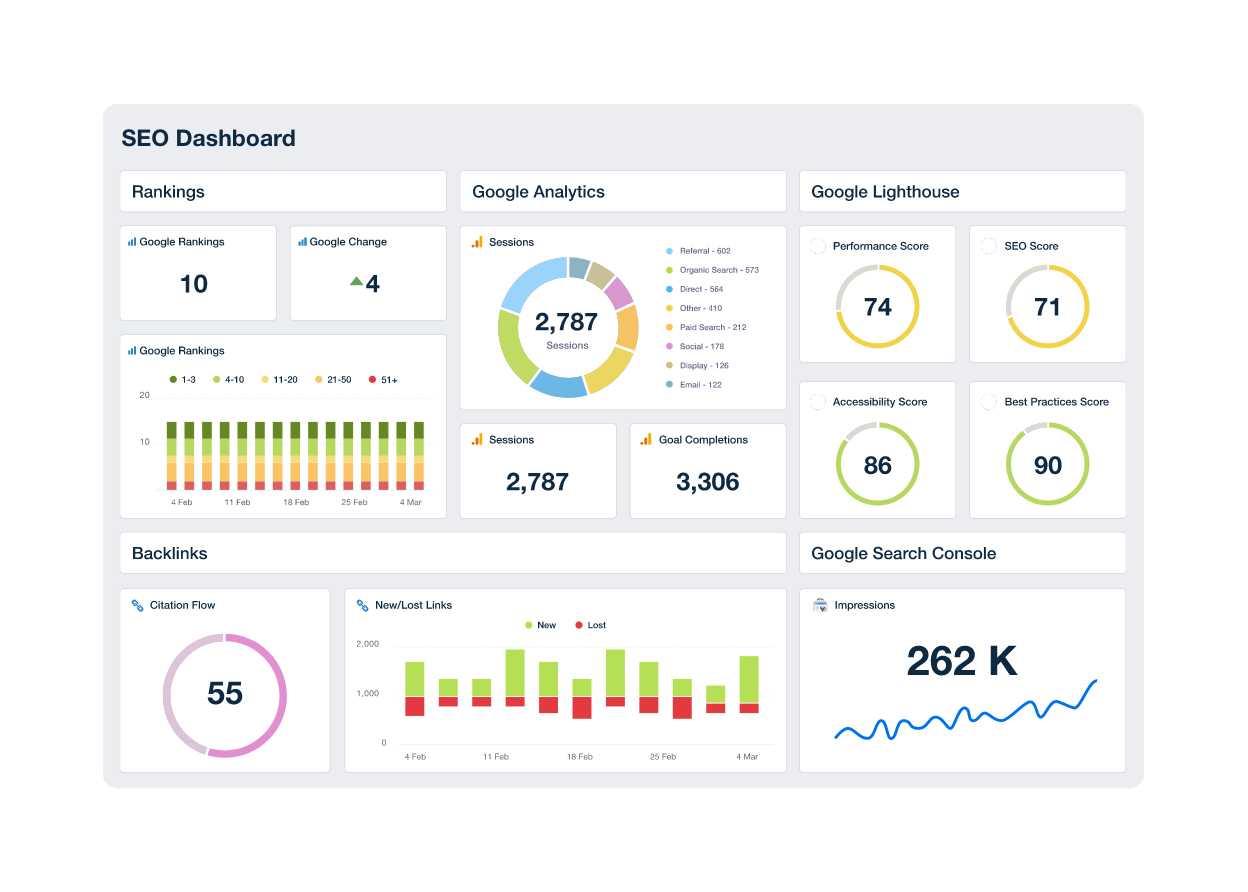
Automatically create and send SEO reports for clients using a customizable SEO dashboard or SEO report template. Try AgencyAnalytics free for 14 days!
4. Content Marketing Metrics
Content marketing is an effective way for marketing agencies to build brand awareness and establish thought leadership within their respective industry. By tracking content metrics such as keyword rankings, page views, time spent on page, and click-through rates (CTR), marketing teams determine which content resonates most with the target audience and identify topics that should be explored further in future campaigns.
Content is often considered a primary driver of SEO success, but it can be much more than that, depending on how the content is created and syndicated.
Engagement is a key metric to monitor when assessing the performance of content marketing campaigns. This metric measures how readers, whether they are new or existing customers, interact with your content regarding likes, comments, shares, and other forms of engagement.
Reach is another important metric for evaluating the effectiveness of content marketing efforts. Reach refers to how many people have seen the content, so tracking this metric is essential for understanding how effective marketing campaigns are in spreading awareness and driving traffic to the website.
Finally, it’s also important to track leads generated from content marketing campaigns to measure success.
We are phone call/lead form oriented. These are the actionable metrics we use. We do use what would be considered vanity metrics as a barometer in some instances. For example, when in the first couple months of an SEO campaign, impressions are helpful to show an increase in visibility and that the campaign is moving in the right direction.
- Michael Stearns, Ascend Digital Agency
Automatically track the keyword rankings for new content that has been created using the built-in SERP Rank Tracker. Try AgencyAnalytics free for 14 days!
5. Social Media Marketing Metrics
Social media marketing is one of the most effective channels for marketing teams to reach and engage with their target audience on social media platforms. To understand how well campaigns are performing, marketing teams should track key social media metrics such as engagement, followers, impressions, and conversions across all social media platforms.
Whether your agency’s focus is on Instagram metrics, Facebook data, LinkedIn analytics, or more–engagement, reach, followers, clicks, and conversions are all part of what makes up a successful social media campaign. But which is the most important to your client? That might depend on where they are in their business lifecycle.
For example, a new business trying to create buzz around town may care more about Facebook Ad metrics such as reach and new followers gained than clicks and conversion. A client trying to launch a new product may lean heavily on YouTube metrics to understand how well their launch videos perform and if they are gaining organic ground on YouTube. While an established eCommerce business may concern itself with engagement and conversions because they understand that followers don’t always become customers.
As you're the expert in the client's eyes, be careful about what data you send to them, as they give everything the same weight. I think making sure you take the time to explain reports and the metrics contained to clients helps them to focus on the right things.
Paul Morris, Superb Digital
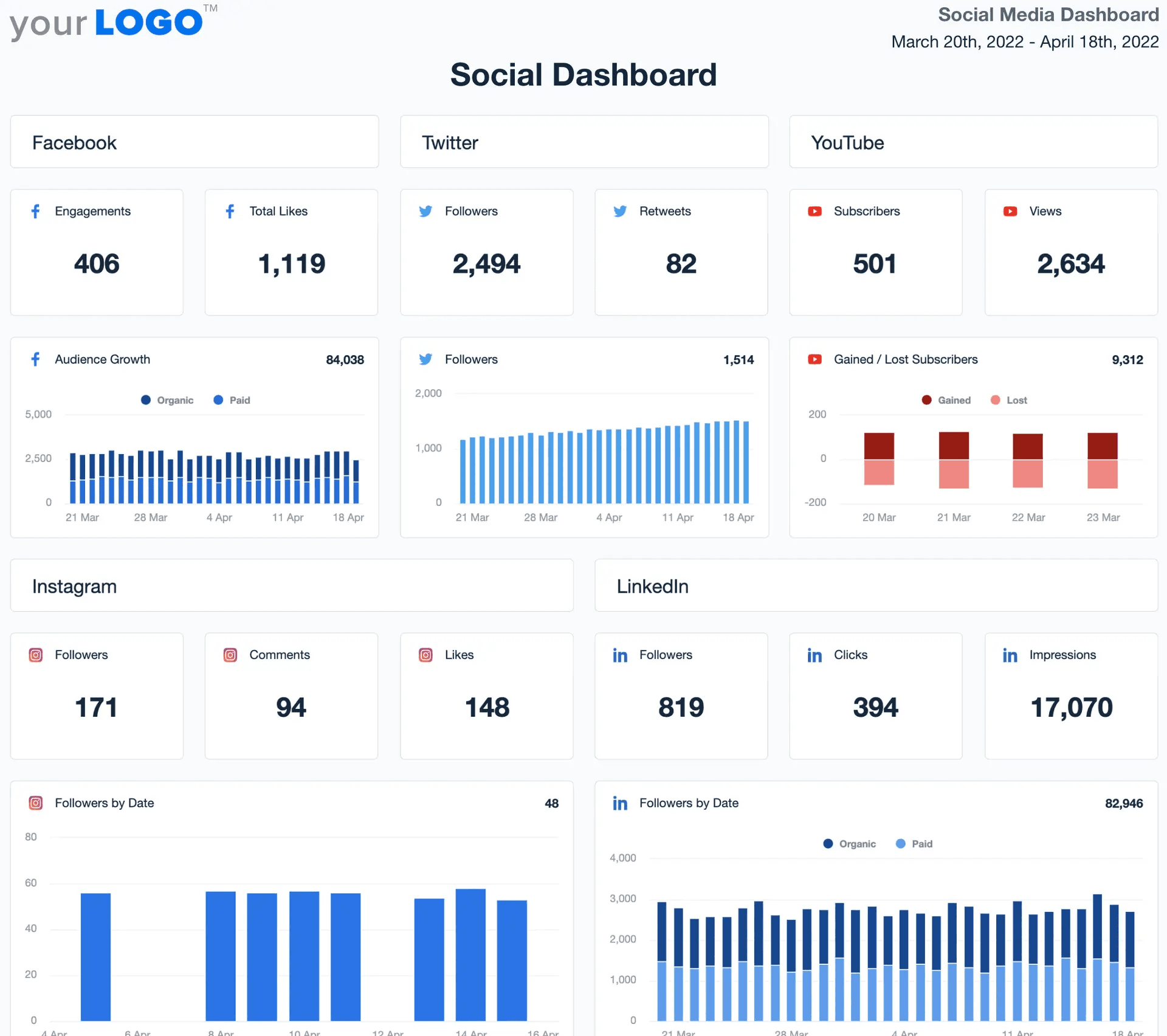
Use a customizable Social Media Reporting Dashboard or a professional Social Media Report Template to automatically create and send client reports in minutes. Try AgencyAnalytics free for 14 days!
6. Email Marketing Metrics
Email marketing is still one of the most cost-effective channels for marketing teams to reach and engage with their target audience and get existing customers to come back to buy more.
To understand how well campaigns are performing, marketing teams should track key strategic metrics such as open rate, click-through rate (CTR), unsubscribe rate, and conversions over time.
Email often is about driving traffic to other brand destinations. You may promote content or products on your website or social profiles, for example. As such, having email metrics integrated into other metrics, such as your website, are hugely helpful.
Seth Giammanco, Minds On Design Lab
There is always a balancing act when it comes to maximizing the KPIs for an email campaign. If users don’t open an email, they aren’t likely going to click on any of the links inside. However, focusing too heavily on open rate–by writing catchy but disconnected subject lines–can improve one marketing metric while reducing the others.
Like the power triangle, the goal is to get the right people to open the email because they are the ones who are more likely to click and purchase and are less likely to unsubscribe. It sounds easy, but it takes a lot of time, effort, and analysis to get it right.
At our agency, we believe that metrics are only useful if they help to drive decision-making. As a result, we focus on identifying actionable metrics that can be used to inform and improve our marketing efforts. To do this, we start by taking a close look at our goals and objectives. We then identify the key performance indicators (KPIs) that will help us measure progress toward those goals.
Guy Hudson, Bespoke Marketing Plans
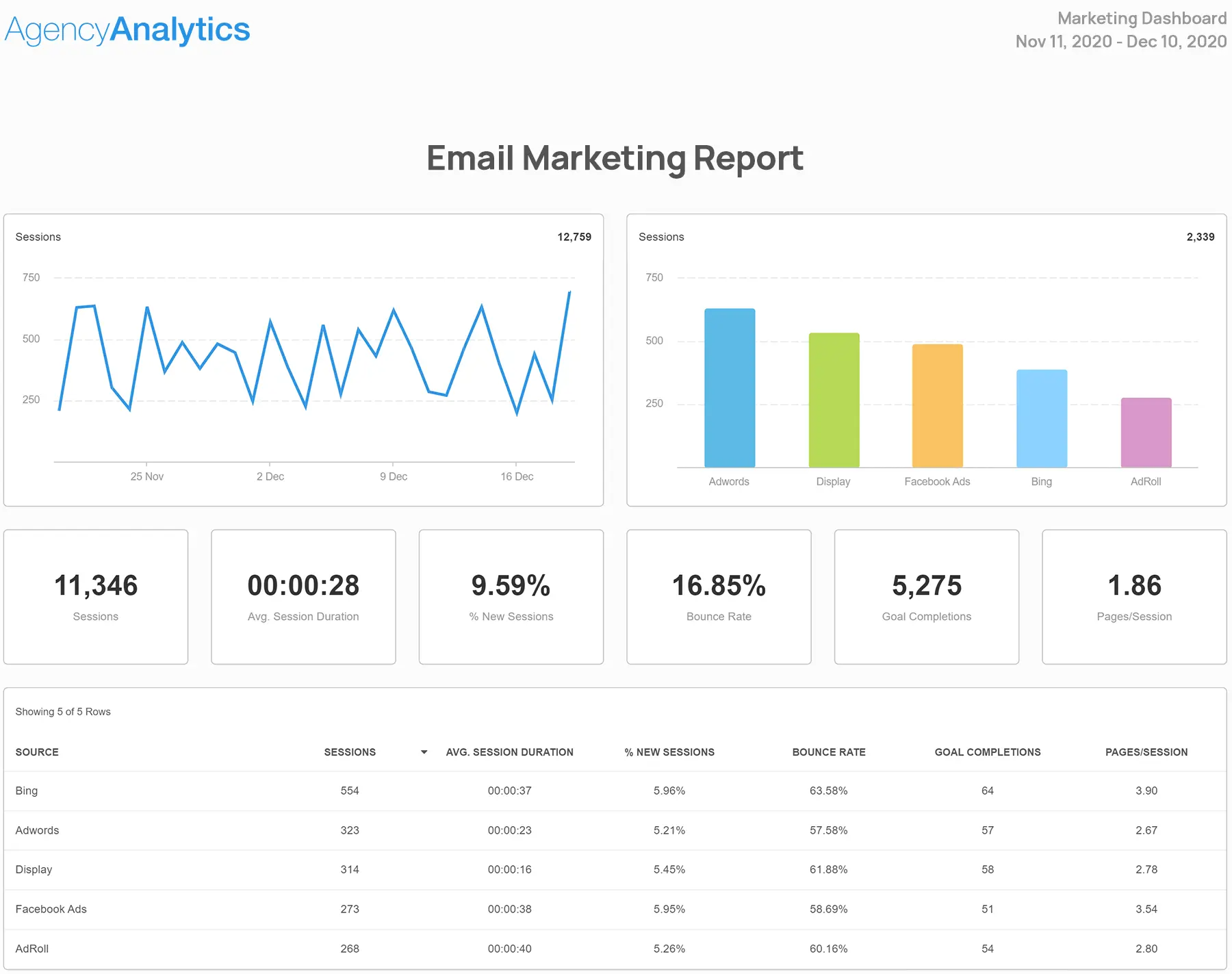
Clearly communicate your agency's success in driving revenue and ROI with a customizable Email Marketing Report Template. Try AgencyAnalytics free for 14 days!
7. Local Marketing Metrics
Ferguson Dental in Brandon, Florida, or Joe’s HVAC in Des Moines, Iowa, probably don’t care about the average CPC for Google Ads in New York, nor how many followers they have in Australia.
As they should, local marketing metrics take things to a local level. These metrics provide marketing teams valuable insight into how marketing campaigns perform in specific geographic areas.
For example, local SEO performance metrics include organic search rankings, website traffic from local searches, and mobile visits, which marketing teams can track to better understand how campaigns perform in specific target markets.
Impressions, visits to website, calls, driving directions are the most important positive metrics to get a broader viewpoint if growth is happening in your local community. Calls seem to be the most important metric to many of our clients. The more calls come in, the more business feels busy. In reality, people expect to find the information they seek online without interacting, and they won't call unless you force them to. They might be down the road onto a competitor if you don't offer other ways to engage.
Kira Krostag, Site Smart Marketing
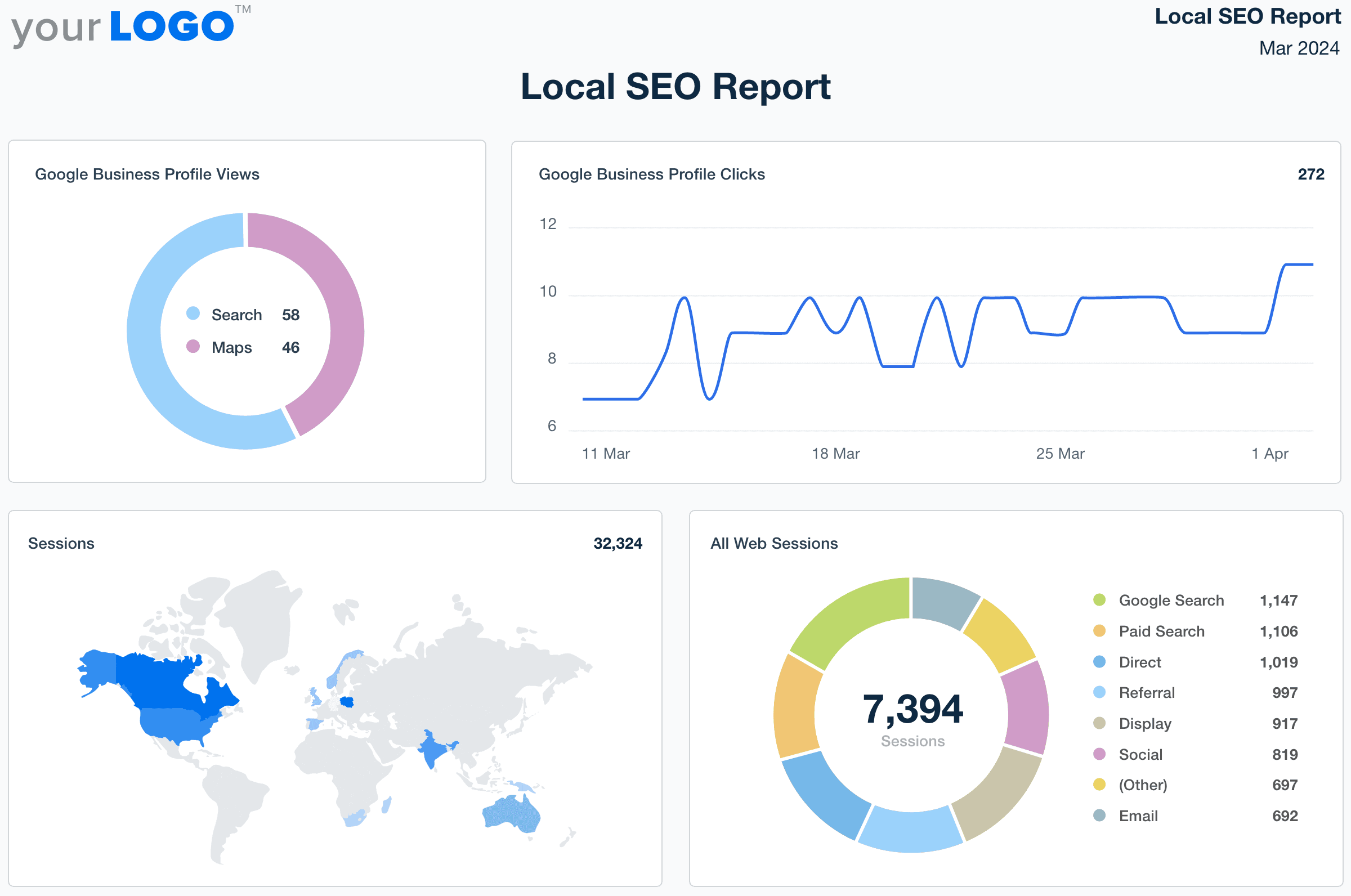
Save billable hours by streamlining your client reporting processes using a customizable Local SEO Report Template. Try AgencyAnalytics free for 14 days!
From website and SEO metrics to social media and email marketing metrics, each channel offers valuable insights into your business performance, marketing ROI, and how effectively you're reaching your target audience and attracting new customers.
Summarizing the Top Marketing Metrics by Channel
To recap, understanding the performance of different marketing channels is crucial to optimizing your clients' marketing strategies and driving the best results for the business. Key performance indicators (KPIs) vary by channel, reflecting unique goals and audience behaviors.
Here's a comprehensive table that encapsulates the crucial metrics for each channel, making use of tools like Google Analytics and AgencyAnalytics to help track and analyze these metrics:
Marketing Channel | Examples of Marketing Metrics |
|---|---|
Website Metrics | Total Traffic, Bounce Rate, Average Session Duration, Pages per Session, Conversion Rate, often from Google Analytics data |
Paid Marketing Metrics | Click-through Rate, Cost per Click, Conversion Rate, Cost per Lead, Return on Ad Spend |
SEO Marketing Metrics | Organic Traffic, Bounce Rate, Keyword Rankings, Backlink Count, Click-through Rate from Search Results |
Content Marketing Metrics | Page Views, Time Spent on Page, Social Shares, Conversion Rate, New vs. Returning Visitors |
Social Media Marketing Metrics | Follower Count, Engagement Rate (likes, shares, comments), Click-through Rate, Conversion Rate, Retention Metrics |
Email Marketing Metrics | Open Rate, Click-through Rate, Conversion Rate, Unsubscribe Rate, Bounce Rate |
Local Marketing Metrics | Google My Business Views, Clicks to Call, Clicks for Directions, Local Keyword Rankings, Reviews and Ratings |
The Importance of Clarity and Transparency With Marketing Metrics Reporting
Reporting important marketing metrics to clients is not just a routine task; it's a powerful tool to showcase the value your agency brings to the table. It proves that your marketing efforts are driving business success, contributing to marketing ROI, reducing customer acquisition cost and increasing customer lifetime value.
Choosing the right marketing metrics to report on is critical. The key performance indicators (KPIs) should align with the client's business objectives and marketing strategy.
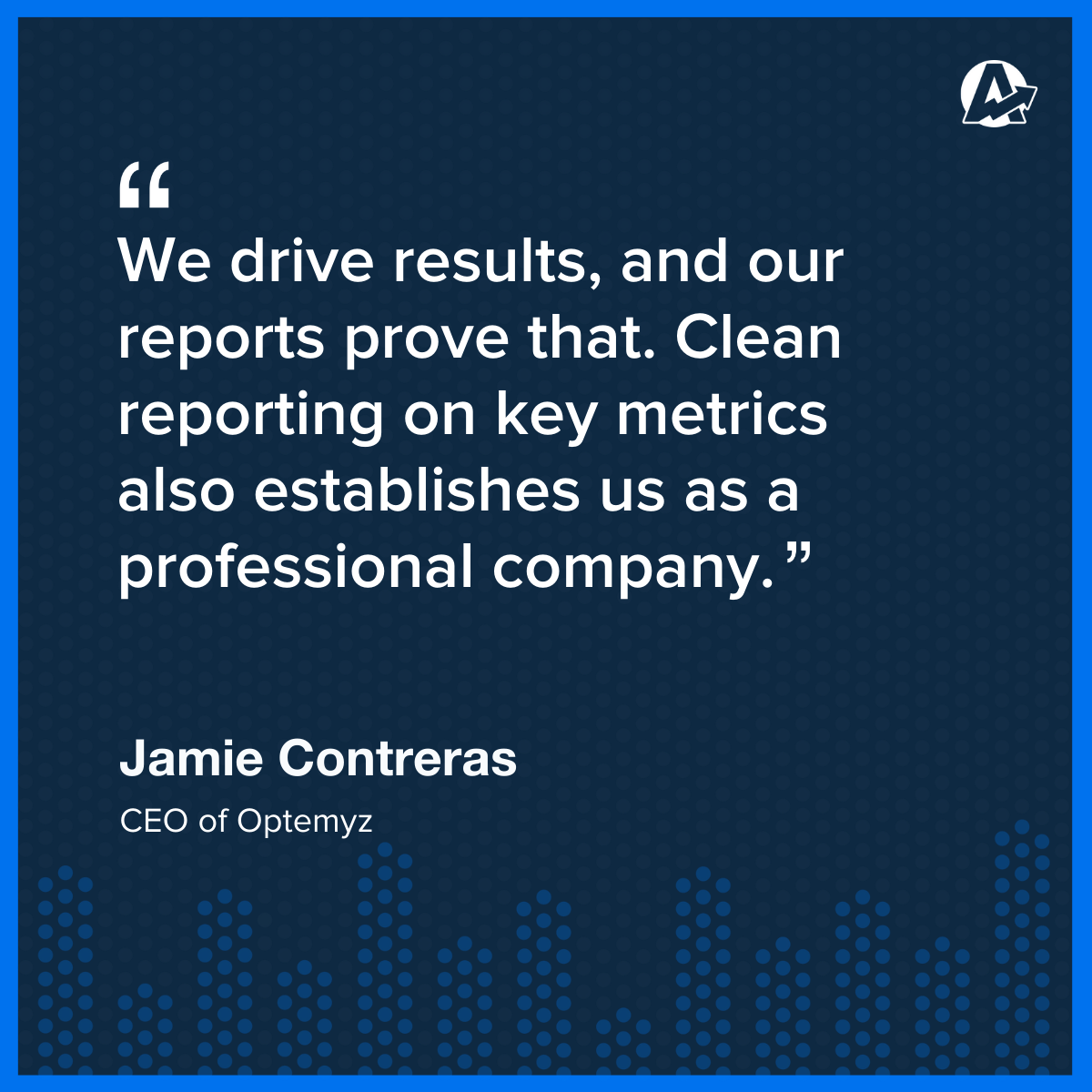
For example, conversion metrics would be vital if a client's goal is to increase online sales. On the other hand, if brand awareness is the focus, metrics like reach and impressions would be more appropriate.
The practice of identifying and pulling together key marketing metrics from various marketing platforms like Google Analytics, Google Ads, Facebook Ads, Keyword Ranking Tools, and more into a comprehensive client report is integral for any marketing agency.
But that doesn’t mean it’s always easy.
Time is our most valuable asset. It's what we sell to our clients in the form of expert digital marketing services, so it's crucial that we manage it as efficiently as possible. We were manually cobbling together data from different sources and taking countless screenshots. It was a stressful, time-consuming process that took away from the billable hours we could be spending on delivering real value to our clients.
Adam Binder, Creative Click Media
One of the most significant challenges marketing agencies face is the cumbersome process of gathering data from multiple platforms to create comprehensive client reports. Each platform has its own set of metrics, reporting styles, and export formats.
This results in agencies spending countless hours extracting data, trying to align disparate metrics, and formatting them into a consistent, readable report. It's not uncommon for agencies to lose precious hours that could have been spent on strategic planning or creative work just wrestling with data. This process is not frustrating, it can also potentially lead to inaccuracies in the report due to manual errors while copying and pasting the data.
Let’s be honest, when was the last time you got near the end of creating a client report only to realize you were pulling different date ranges for at least one of the platforms? It probably wasn’t that long ago, was it?
Such inefficiencies underscore the need for an integrated solution that can automate and streamline the data gathering and reporting process.
Different Reporting Methods and Their Pros and Cons
There are several methods for reporting the most important marketing metrics to clients, each with its own pros and cons.
Reporting Method | Pros and Cons |
|---|---|
Manual Reporting | This involves manually pulling data from various marketing platforms and compiling it into a report. While this gives complete control over what data is included, it can be time-consuming and prone to human error. |
Platform-Specific Reporting | Many platforms, like Google Analytics, offer their own reporting features. These can save time and reduce error, but they often lack customization and may not include all the data you need. Plus, if your agency is handling multiple platforms, it means creating multiple and disjointed reports. |
Automated Reporting Software | Reporting software solutions like AgencyAnalytics offer a more balanced approach. They automate data collection and report generation but also allow for customization to fit specific client needs. This method ensures that your agency efficiently delivers accurate, comprehensive reports, offering a clear view of marketing results. |
AgencyAnalytics gives our clients clarity and confidence because of how easily we can communicate our efforts and results to them on a frequent, consistent basis. The large number of integrations allows us to report on all activities in one cohesive, comprehensive, beautiful report instead of a bunch of disjointed pieces of information. It really elevates our professionalism and is part of what allows us to charge the prices we know we're worth.
Lane Anderson, Founder & CEO, London Road Marketing
Effective reporting of the right marketing metrics is critical for proving the value of your agency to clients. It bridges the gap between the sales team and the marketing team, aligns strategies with business objectives, and ultimately drives business success. With the right tools and approach, your agency can deliver these benefits consistently and efficiently.
We take a data-driven approach to all of our marketing strategies at Native Rank. Transparency and communication are key to a successful partnership, and we make sure our clients are always informed about the progress of their campaigns and have access to the data and insights they need to make informed decisions about their digital marketing strategies.”
Daniel Dye, President of Native Rank
How To Measure and Report on Marketing Metrics Using AgencyAnalytics
Once you have identified the right marketing metrics (aka, the ones that are most important to your client), AgencyAnalytics to track and monitor all of the digital marketing analytics and marketing KPIs in one place. The platform includes built-in integrations with over 80 marketing tools–at no extra cost–and allows users to easily visualize marketing performance data in one place.
Plus, SEO add-ons bring a word of keyword optimization to your fingertips.
Create custom metrics and reports to present performance in an engaging way. This makes it easier for clients to understand how marketing activities are contributing towards meeting their goals–giving them confidence in the value of your agency’s services.
The advanced reporting system provides easy-to-read marketing dashboards, graphs, and tables so that clients can quickly identify key trends or areas of opportunity within the data. In addition, AgencyAnalytics offers automated report scheduling functionality to send marketing performance reports to clients at a frequency that suits their needs. This helps marketing teams save time and resources as they don’t have to manually create marketing reports each month.
Our clients don't want a full-scale report–they want us to show them the metrics they care about. The dashboard gives our clients the ability to quickly understand what they're looking at, how it works, and what it means for their bottom line.
Ruben Roel, Investigator Marketing
Bottom Line: Win Back Billable Hours by Streamlining Your Marketing Metrics Reporting
AgencyAnalytics is designed to simplify reporting for marketing agencies so you don’t have to manually pull data from multiple sources. No more spending hours gathering and cross-referencing data from different marketing channels–it’s all pulled together into one place.
This makes it easy to monitor marketing metrics over time and quickly identify key trends or areas of opportunity within the data.
Save countless hours each month by automating your data-retrieval process and housing all your clients’ unique marketing metrics under one roof. Start your free 14-day trial today and discover why over 7,000 agencies use AgencyAnalytics.
When we onboard our new partners, we show them a full live example of the reporting and how easy it is to view real live data in one place. This is definitely a winning experience for our partners and us. They understand that they are also saving time by being able to view all these important metrics all at once.
Justin Hual, HIP Creative
If you want your marketing report templates to resonate with clients, simplify data presentation, align your metrics with your clients' interests, and consistently impress them with your success story.
Summary and Key Takeaways
Understanding and utilizing marketing metrics is a crucial cornerstone for any successful marketing agency. These metrics serve as the lifeblood of strategic planning and decision-making, ultimately driving customer acquisition, enhancing customer lifetime value, and boosting overall business performance for your clients.
This article dove into the importance of tracking, interpreting, and reporting key marketing metrics, from conversion metrics to net promoter scores. We discussed the essential role of marketing metrics in various aspects of marketing, including identifying successful strategies, optimizing marketing spend, and showcasing the value your agency provides.
We explored the concept of the Marketing Metrics Power Triangle, a strategic model that balances traffic, conversion, and average order value to optimize a client's business. This triangle acts as a roadmap, guiding agencies to focus on the metrics that genuinely move the needle.
We also emphasized the significance of effective reporting to clients. This is where marketing-qualified leads and sales-qualified leads take center stage, serving as vital indicators of marketing effectiveness. However, the challenge often lies in the time-consuming process of pulling together data from various platforms to generate these comprehensive client reports.
Harnessing the power of marketing metrics and effectively communicating them to your clients is integral to your agency's success. It not only aligns sales and marketing teams but also helps you craft compelling marketing strategies that deliver tangible results, reaffirming your agency's value and strengthening your client relationships. Streamline your client reporting. Start your free 14-day trial with AgencyAnalytics today.
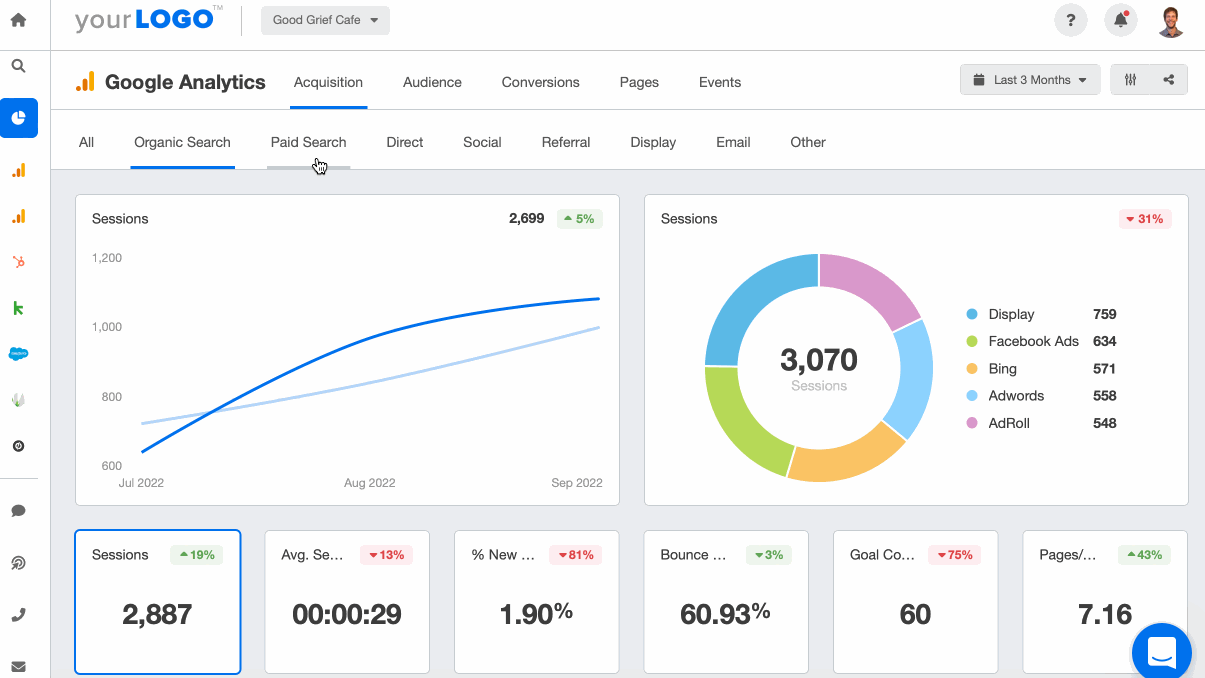
Using the AgencyAnalytics reporting platform has been a game-changer for our agency. It saves us time by automating manual reporting processes, allowing us to focus on strategy and delivering better results for our clients. Overall, the platform enhances our operational efficiency, elevates the quality of our reporting, and drives our agency's growth and reputation for excellence.
Joseph LeBlanc, Studio Eighty-Eight

Written by
Paul Stainton is a digital marketing leader with extensive experience creating brand value through digital transformation, eCommerce strategies, brand strategy, and go-to-market execution.
Read more posts by Paul StaintonSee how 7,000+ marketing agencies help clients win
Free 14-day trial. No credit card required.



